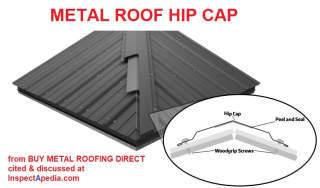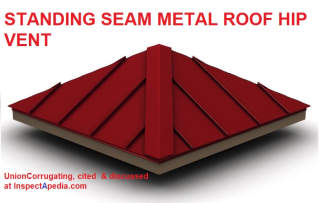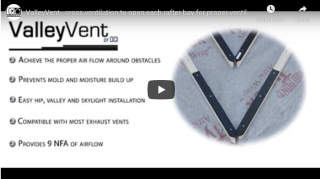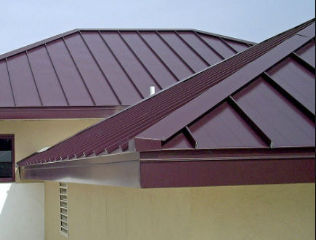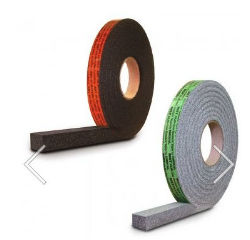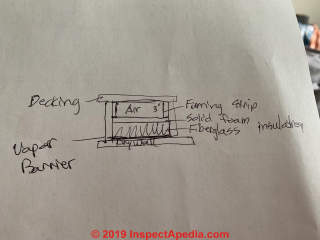 Hip Roof & Cathedral Ceiling Ventilation
Hip Roof & Cathedral Ceiling Ventilation
Roofs or ceilings where ventilation is difficult, not feasible, not wanted
- POST a QUESTION or COMMENT about un-vented cathedral ceiling under-roof spaces
Solutions for roofs or ceilings that are hard to vent: hip roofs, odd roof shapes, hot roof designs, aka dense-packed insulated sloped roofs.
Page top illustration: a wafer cut along the ridge suggested by DCI Products, cited in detail just below.
Data & design suggestions for hip roof vents, cathedral ceilings, hot roof designs or for providing roof and ceiling ventilation, and we describe roof & roof insulation or venting system inspection methods and clues to detect roof venting deficiencies, insulation defects, and attic condensation, mold, or structural damage problems in buildings covered by an un-vented or hot roof or hard-to-vent roof design.
InspectAPedia tolerates no conflicts of interest. We have no relationship with advertisers, products, or services discussed at this website.
- Daniel Friedman, Publisher/Editor/Author - See WHO ARE WE?
How to Vent to a Hip Roof
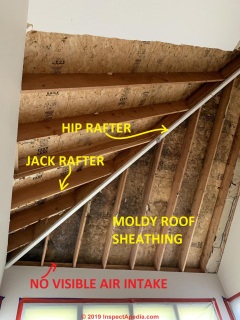 Reader Question: how can we vent this closed-off hip roof portion of our home?
Reader Question: how can we vent this closed-off hip roof portion of our home?
2019/08/07 Daniel said:
We had our roof replaced 2 years ago due to a wind storm. Asphalt shingle roof. Previous roof was original to house built in 1993. We have an angled cathedral ceiling in our great room. This past March we noticed moisture running down the center beam and then eventually moisture in the Sheetrock.
See pictures for extent of damage discovered.
How do we ventilate or properly insulate this section of our home? There are soffit vents but as you can see no outtake venting.
[Click to enlarge any image]
Reply:
Daniel
Thanks for asking a helpful question; indeed there are some roof shapes that are difficult or nearly impossible to vent effectively.
One of them, that I think is shown in your photo, is a roof area under a hip. In your photo the hip line or under-side of the hip rafter is that white diagonal across the image.
While some roofers install a "ridge vent" all along the hip, fed by continuous soffit intake venting, that's rare; I suspect the worry is leaks into the hip vent low on the roof near the eaves.
GAF makes a low profile Cobra Vent for hip roofs - a hip vent specifically for this purpose; I don't think GAF, a leading roofing manufacturer, would recomment venting along the hip unless they were confident of the leak resistance of their Cobra Hip Vent installation.
Other roof vent suppliers include a similar vent but made of mesh that can also be applied over a hip.
Watch out: partial vent systems such as spot vents or "mushroom vents" between hip rafters are suggested by some writers, even ones we like such as Fine Homebuilding.
But they're not the best approach: these will not vent the entire under-roof area and are in my experience considerably less effective - an incomplete solution. However, depending on the hip roof venting system you install, even installing a hip exhaust vent (such as GAF's Cobra Vent) won't vent the lower half of the hipped roof. An incomplete solution in my experience.
Watch out: other writers suggest using fans or power-venting the hip roof area;
This might work (somewhat) provided that the hipped roof is over an attic rather than enclosed as a cathedral ceiling AND provided there is good air flow in along the hip roof eaves or soffits and enough air movement that **all** of the under-roof sheathing is kept dry.
I've seen mushroom vented and power fan vented roofs whose decking looked great around the fan but that was mold-hell just a couple of hip jack-rafters away.
You'd install the vent along the hip by the following steps:
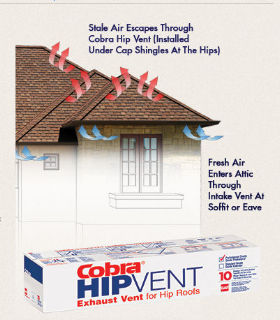 1. Remove the existing hip cap shingles
1. Remove the existing hip cap shingles
2. Cut back roof sheathing 1 to 1 1/2" away from the hip rafter on both sides of the hip rafter, for the full length of the rafter. Don't cut all the way to the gable end or hip top or bottom. The object is to have a 1" to 1 3/4" open slit along the hip on each side.
Watch out: see GAF's warning about hip roof vent slot location given below; the company says never cut hip air slots below th mid point of the hip - and other restrictions that basically mean that you will not be able to vent the entire hipped roof underside.
DCI's wafer cut method suggests that that company vents the entire hipped area. Check with your vent supplier before cutting into the roof.
DCI Products illustrates a clever way to cut back the roof sheathing along the hip rafter so as to retain sufficient nailing connections between the roof sheathing and the roof structure, though for many hip roof designs, the nailing of the roof sheathing to the hip rafters themselves ought to be more than adequate.
3. Install the hip vent (by Cobra [GAF] DCI, or another supplier) - follow their instructions for cut dimensions, vent nailing, etc.
Inspect the roof sheathing and roof condition - if possible from below - to assure that you're not leaving rotted or insect-damaged sheathing in place. If you find those the repair job needs to expand to replace any bad roof sheathing.
The installation manual for GAF's Cobra Hip Vent as well as other hip vent products and instructions are found below on this page.
4. Install new hip cap shingles to cover the hip vent.
5. Vent the soffit or eave: Assure that there is complete, continuous, un-blocked intake venting along both eaves below the hip roof area; if your roof has NO overhang then you might still install intake venting at the lower roof sheathing edge - we discuss that intake vent in this article series.
6. Clean the under-roof of any mold: For your roof I'd do some surface-clean-up of that moldy roof sheathing, It's not necessary to remove all of the dark mold stains on plywood - physically clean the surface and seal it.
and while we don't normally bother, in this case as you're going to enclose the roof cavity and don't want to do this job over again, I'd spray sealant such as a FUNGICIDAL SEALANT PAINT (search InspectApedia.com for
FUNGICIDAL SPRAY & SEALANT USE GUIDE to see details) over the roof framing and sheathing where it's exposed.
7. Assure the air path: When re-insulating, be SURE to leave 2" or more of air movement space up under the roof sheathing for the whole roof area - from eaves or soffit intake out to the hip vent outlet. Some roof baffles give only an inch or less of space - in my experience that's often not adequate.
So don't pack a "vented" roof cavity with insulation.
8. Add insulation: To get the required R-value for the roof, depending on where you live, you may need to add additional solid foam insulation to the underside of the rafters before re-installing the drywall.
9. Re-install ceiling drywall. Take care to avoid air leaks into the roof space from the building interior.
Alternative to a Roof Hip Vent: go to a hot roof design? Probably not.
An alternative is to abandon trying to vent the hipped area, converting the roof to a HOT ROOF DESIGN (search InspectApedia.com for
HOT ROOF DESIGNS: UN-VENTED ROOF SOLUTIONS to read those details) but even in that approach I'd clean the cavity first.
Watch out: trying to go to a hot roof design (insulating with closed cell foam is probably best though I've also done open cell foam) you will find that few or no foam insulation contractors are going to be interested in bidding on a very small partial-roof foaming project - the overhead of coming to the site to inspect, measure, bid, and sell the job just isn't worth the trouble. It's a money loser.
Post some outdoor photos so we can better understand this roof and I may be able to offer further comments.
Hip Roof Ventilation Products & Installation Manuals
Illustration above: hip roof vent for a metal roof, excerpted from the Tuff-Rib Installation Manual cited below under supplier Buy Metal Roofing.com - the venting properties of this metal roof hip cap are not quite clear in the manual cited below: check further with the manufacturer. Note also that this is an exposed-metal-fastener metal roof, not a standing seam metal roof product.
Below: a hip vent for a standing seam metal roof, provided by Union Corrugating, cited below.
Watch out: discuss with your roof vent manufacturer whether there is a need for baffles in the product to prevent leaks from wind-blown rain and snow.
- Air Vent, Inc. 4117 Pinnacle Point Drive, Suite 400 Dallas TX 75211 Tel: (800) AIR-VENT, Email: ventilation@gibraltar1.com Website: www.airvent.com/index.php/products/exhaust-vents/ridge-vents/hip-ridge-vent
Illustration above: Boral Roofing's Hipmaster vent for hip roofs.
- Boral Roofing RIDGEMASTER - HIPMASTER ROOF VENT BROCHURE [PDF] (2018) , Tel: 800-971-4148, Website: https://www.boralroof.com/
Excerpt: Inspire 11 inch HipMaster Roof HIP Vents. 4-Feet Long x 10-5/8 inch Wide. Commonly used with RidgeMaster Plus Ridge Vents.
Boral's roof ridge and hip vents are used on metal roofing, composite/slate roofing, wood shingle roofs, and the company also provides a hidden fascia intake venting system. - Buy Metal Roofing Direct Co.,Tel: 877-893-5449
Website: https://www.buymetalroofingdirect.com/ Email: support@buymetalroofingdirect.com
TUFF-RIB METAL ROOFING INSTALLATION MANUAL [PDF] (2016) Emseal (a SIKA company), for metal roofing, provided by Buy Metal Roofing Direct, [cited above] retrieved 2021/02/15, original source: https://cdn.shopify.com/s/files/1/0922/4916/files/BMRD_Install_Guide-compressed_02_12_2021.pdf?v=1613142833
- DCI Products, DCI Products is located at 415 South Penn St Clifton Heights, PA 19018 800-622-4455 info@dciproducts.com website: https://dciproducts.com/valleyvent/ - this venting approach for roof valleys can work at hips, valleys, chimneys, and possibly some skylights or dormer roofs - Ed.
Website excerpt:
ValleyVent is an under-plywood, top-of-rafter vent easily installed during the construction of an addition or a new home. The ValleyVent provides adequate ventilation in the spaces to either side of the vent placement.
It is a required vent product when your soffit to ridge air flow is blocked by a skylight or dormer. ValleyVent easily allows air movement in those trapped areas.
It eliminates the need to drill holes in the rafters to ventilate areas trapped by construction supports. Use it in areas otherwise unventilated and considered problem areas. It is very versatile and can be used on wall surfaces between siding and wall sheathing, allowing air to move between those areas.
ValleyVent can also help stop mold and mildew when installed properly.
Above: Emseal tapes are used to avoid leaks at roof hip and ridge vent systems.
- Emseal SEALANT TAPE INSTALLATION INSTRUCTIONS [PDF] Emseal Joint Systems, Ltd. 25 Bridle Lane, Westborough MA 01581 USA
Emseal, LLC, 120 Carrier Drive, Toronto, Ontario Canada M9W 5R1
Website: www.emseal.com retrieved 2021/02/15 original source: https://cdn.emseal.com/specialty-gaskets-tapes/wp-content/uploads/sites/2/2016/09/sealant-tapes-install-data-sheet-emseal.pdf
Excerpt: Emseal metal roof and building sealants are self-adhering tape seals made from resilient, open-cell polyurethane foam impregnated with a water-based acrylic-modified asphalt emulsion (AST Hi-Acrylic) or a water-based, acrylic impregnation (MST). They replace and outperform liquid sealants, butyl-tape sealants and closed-cell closures.
 Illustration: a wafer cut along the ridge suggested by DCI Products, cited in detail just below.
Illustration: a wafer cut along the ridge suggested by DCI Products, cited in detail just below.
[Click to enlarge any image]
- DCI Products, SmartRidge Hip Roof Ventilation System, DCI Products is located at
415 South Penn St
Clifton Heights, PA 19018 USA
800-622-4455
info@dciproducts.com Website: https://dciproducts.com/hip-roof-ventilation/
DCI illustrates 6" "Wafer Cuts" along the hip - shown here - more details are at the link we gave just above. These cuts open the roof sheathing back 1 3/4" along each side of the hip.
Also see
SMARTRIDGE I INSTALLATION INSTRUCTIONS [PDF]
SMARTRIDGE II INSTALLATION INSTRUCTIONS [PDF] for widths 10 1/2", 8 1/2" &^ 7"
Above: Cobra Hip Vent, produced by GAF, is discussed in detail in the article above on this pageand cited just below.
- GAF's Cobra Hip Vent is shown below and at www.gaf.ca/roofing/residential/products/roof_vents/cobra_hip_vent
GAF COBRA HIP VENT INSTALLATION INSTRUCTIONS [PDF], retrieved 2019/08/07 original source: https://www.gaf.ca/Residential_Roofing/Attic_Ventilation_Products/Cobra_Hip_Vent/Cobra_Hip_Vent_Installation_Instructions_English_Spanish_French.pdf
Excerpts:
Important Slope Restrictions: Use only on roofs with slopes between 3:12 and 12:12.
Install only on hips. Do NOT install Cobra® Hip Vent on ridges.
Roof Deck: Use minimum 3 /8” (10 mm) plywood or oriented strand board (OSB) decking as recommended by APA-The Engineered Wood Association. Wood decks must be well-seasoned and supported, having a maximum 1 /8” (3 mm) spacing and using a minimum nominal 1” (25 mm) thick lumber with a maximum 6” (152 mm) width, having adequate nail-holding capacity and a smooth surface.
Cobra® Hip Vent has 9 Sq. In. of NFA per lineal foot (19,051 mm2 of NFVA per lineal meter) [36 Sq. In. per 4’ vent (23,227 mm2 per 1.22 m vent)]. To determine the amount of Cobra® Hip Vent needed, please see the ventilation calculation in Step 1 of the complete installation instructions available on gaf.com.
Watch out: Hip Air-Slot Location: To ensure proper exhaust ventilation and weather resistance, NEVER cut hip air slots below the midpoint of the hip. Do NOT cut air slots less than 24” (610 mm) in from the building’s warm exterior wall (see Step 2, “Cutting Hip Air Slots”).
... For optimal aesthetics, GAF recommends installing Cobra® Hip Vent the entire length of the Hip (eave to ridge). Any vent sections installed below the midpoint of the hip must NOT be vented and does NOT count toward the exhaust net free venting area required for the roof.
Watch out: See also this GAF WARNING ABOUT SNOW INFILTRATION at RIDGE VENTS [PDF] retrieved 2019/08/07 original source: https://www.gaf.ca/Residential_Roofing/Attic_Ventilation_Products/Cobra_Hip_Vent/InfoFlash_Snow_Infiltration_Ridge_Vents.pdf
GAF FAQs excerpts on the above: During two years of design and development, GAF rigorously tested the Cobra® Hip Vent internally and at third-party accredited laboratories to ensure it provides maximum weather resistance and ventilation performance. ... Cobra® Hip Vent has a two piece filter system, called the Dual Weather Fighter™ Filter. This system
helps resist weather infiltration both through and under the vent.
Watch out: Do NOT use Cobra® Hip Vent on ridges. It is specifically designed to provide maximum weather resistance on the hip areas of the roof. GAF recommends using Cobra® ridge vents for all ridge venting.
- Union Corrugating Co., Corporate Headquarters
701 S. King St.
Fayetteville, NC 28301 USA, Tel: 888-685-7663 Website: https://www.unioncorrugating.com/ Website disponible en Espanol.
Excerpt:
Union offers both exposed fastener metal roofing systems and concealed fastener standing seam metal roofing systems.
Reader follow-up:

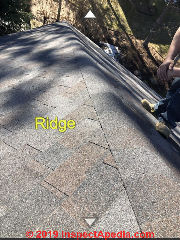
Thank you for your reply. Yes we have an overhang on the soffits. Do you use baffles to provide the 2 inch air space? What about a vapor barrier on the sheeting side of the insulation?
Moderator reply:
I've used styrofoam baffles and found them marginal at best when run all the way from eaves to ridge under a cathedral ceiling- the air space doesn't extend the full width of the sheathing between the jack rafters and often it squashes down to an inch or less - there's too little air movement.
CATHEDRAL CEILING VENTILATION has more details.
Either leave a good 2" above your insulation or go to a more labor intensive furring strip (to get the air space) and solid foam (between rafters) or give up and go to a HOT ROOF
I like a vapor barrier on the warm side of the ceiling under the drywall, but studies have shown that most of the air and moisture leaks into the roof space are not THROUGH the drywall but rather at PENETRATIONS.
I see your soffit overhang and though I can't see them it may have perforated panels but your earlier photo shows blocking between the jack rafters - no airflow was apparent.
Reader follow-up:
Does going to the hot roof option eliminate the ventilation condensation problem assuming no moisture entry from the roof side? I assume would remove the soffit vents as well
Moderator reply:
is more complete than an off the cuff reply here; Basically that design can work but because of the risk and cost of leaks into a foamed, enclosed roof cavity (un-discovered, rot) I prefer that design under very reliable long-lived roof surfaces such as a metal roof.
Reader follow-up:
So if I read all the links correctly I am thinking about going this route.
Moderator reply
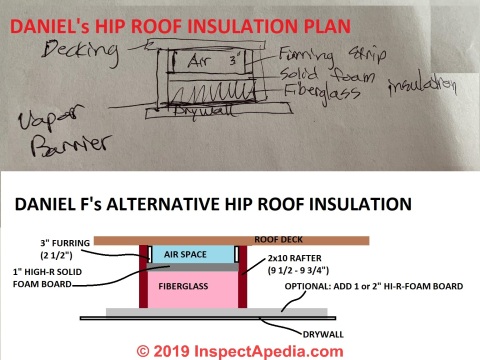 Here is an alternative for homes in cold climates where a higher R-value cathedral (under hip roof or otherwise) ceiling is in order.
Here is an alternative for homes in cold climates where a higher R-value cathedral (under hip roof or otherwise) ceiling is in order.
Some ROUGH calculations:
If your rafters are 2x10 figure that's a true dimension of 9 1/2".
9 1/2" rafter
less 2 1/2" furring (true dimensions rather than nominal) for the air space
less 1" for the solid foam baffle
= 6" to fill with fiberglass. (See INSULATION R-VALUES & PROPERTIES inspectapedia.com/insulation/Insulation-Values-Table.php)
That gives us about
R8 or less (solid foam board 1" thick)
R19 (fiberglass)
= R27 ceiling.
If you need a higher R add another 1" (R8) or 2" (R16) foam board to the rafter bottoms and then install the drywall ceiling over that (using long-enough screws and taking care to map the rafter bottom locations so as to be sure your screws connecty)
Watch out: for leaks into the hip roof near the eaves, especially in areas of heavy rain. See GAF's warnings and see the DCI's design for the hip vent.
Reader follow-up:
Thank you! Yes we live in a cold climate (Spokane Washington) and get a decent amount of snow, so will probably go with the higher R value.
Now just need to get the right hip ridge vent that will vent the entire hip and all rafter bays. Looks like DCI
Moderator reply:
I like foil faced HI-R foam board; you can add another R8 or even R16 - I figure the insulation is cheap compared with the cost of heating the home over the rest of the home's life.
Talk with DCI about GAF's worry about leaks into the lower portion of a hip vent. Let me know what they tell you.
To install the drywall we marked the location of the upper and lower end of every rafter BEFORE covering the rafter bottoms with the foam board. Pencil lines down the walls long enough to not get lost.
Then with the foam board in place we could use those lines (and a string line if needed) to shoot 3 1/2" drywall screws through the foam into the rafter bottoms without missing the rafters. (YOu'll know if you miss the rafter by how the screw behaves).
With foil faced foam board it's a near perfect vapor barrier (and slightly higher R value than kraft faced or unfaced board) so you don't need another VB under the drywall.
Watch out: with an asphalt shingle roof over ANY totally enclosed cathedral ceiling you need to inspect the roof annually to be SURE there are no lost, damaged, leaky shingles as water leaking into any enclosed building cavity can cause a lot of damage before you see clues from the building interior.
Henri DeMarne (JLC conference 1985) showed photos of rotted rafters in HOT ROOF designs that were under leaky roofs.
Yours is a vented roof - that reduces the problem but doesn't eliminate it as that foam board will trap any leaks in the upper roof cavity - you won't see leaks showing up as ceiling stains until things are pretty bad.
Design Suggestions for Unvented “Hot” Roof Designs Where Venting is Difficult
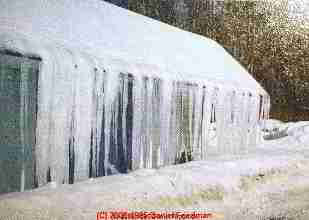 In cathedral ceiling configurations where it is difficult to
provide ventilation, some builders have eliminated the
vent space, relying instead on careful sealing of the ceiling
plane to prevent moisture problems.
In cathedral ceiling configurations where it is difficult to
provide ventilation, some builders have eliminated the
vent space, relying instead on careful sealing of the ceiling
plane to prevent moisture problems.
While experts concede that this should work in theory, most caution that it is difficult to build a truly airtight ceiling assembly.
Also, cathedral ceilings are slow to dry out if moisture problems do occur, whether from condensation or roofing leaks. If a hot roof is the only option for a section of roof, take the following precautions:
- Install a continuous air and vapor retarder, such as
6-mil poly, carefully sealed at all junctures. See the vapor barrier and air barrier articles listed
at VAPOR BARRIERS & CONDENSATION in buildings. - Do not use recessed lights or other details that penetrate the ceiling plane.
- Carefully seal all penetrations in the ceiling assembly,
including top plates of partitions, with durable
materials. See the air leak articles beginning
at AIR BYPASS LEAKS - Use a non fibrous insulation, such as plastic foam,
and install it without voids where moisture could
collect. Insulation choices are listed
at INSULATION INSPECTION & IMPROVEMENT.
While fiberglass insulation is an excellent and effective product for insulating most building cavities, in areas where there is extra risk of trapping moisture (and thus rot or mold infections) such as crawl spaces and cathedral ceilings where roof venting may be absent or minimal, we prefer to use closed-cell foam insulation products or spray-in icynene foam insulation: these products can seal the cavity against drafts and they do not as readily pick up moisture nor do they readily form hidden mold reservoirs.
See MOLD in FIBERGLASS INSULATION
and MOLD RESISTANT CONSTRUCTION for details. - In regions prone to ice dams, use enough insulation to
maintain a cold roof—preferably R-38 or greater.
See ROOF ICE DAM LEAKS - and ICE DAMS: COMPARING TWO HOUSES
- Ice and Water Shield: On roofs that are too difficult to vent, a second-best solution is to remove the shingles (or slates) from the lower 3 feet
of those slopes where leaks and ice dams have been recurrent, install a waterproof but nail-able membrane such as WR Grace's Ice and Water Shield (other product names from other manufacturers) which will prevent any ice dam
backup leaks from entering the building.
This is basically a sticky membrane that is applied to the roof decking and through which shingle or slate nails can be nailed back onto the roof; the membrane seals around the nails so that those penetrations do not form leaks during a water or ice backup. - Use of roof de-icing cables or heat tapes to avoid ice dam leaks is described
at HEAT TAPES & CABLES for ROOF ICE DAMS.
While we prefer to avoid ice dam leaks by good building design and good under-roof ventilation, where conditions require stopping ice dam leaks on an existing structure, proper installation of heating cables may be the fastest and cheapest solution. - Eliminate all sources of excess moisture in the home
(wet basements, uncovered crawlspaces, unvented
bathrooms).
See ATTIC CONDENSATION CAUSE & CURE.
...
Continue reading at RIDGE VENT, ATTIC INSTALL & INSPECT or select a topic from the closely-related articles below, or see the complete ARTICLE INDEX.
Or see these
Recommended Articles
- ATTIC CONDENSATION CAUSE & CURE
- Best Practices Guide to Residential Construction, chapter on BEST ROOFING PRACTICES
- CATHEDRAL CEILING VENTILATION
- CATHEDRAL CEILING INSULATION
- COOLING LOAD REDUCTION by ROOF VENTS
- HARD to VENT ROOF SOLUTIONS for HIPS & CATHEDRAL CEILINGS
- CAPE COD ROOF & KNEE WALL INSULATION & VENTILATION
- CAPE COD ROOF VENT or DENSE PACK INSULATE
- INSULATE ROOF with SOLID FOAM BOARD + AIR SPACE
- INSULATE ROOF with SPRAY FOAM
- INSULATE ROOF with DENSE PACKING
- HOT ROOF DESIGN PROBLEMS
- HOT UN-VENTED ROOF DESIGN SOLUTIONS
- RIDGE VENT, ATTIC INSTALL & INSPECT
- ROOF VENT if NO SOFFIT
- STANDING SEAM METAL ROOF INSTALLATION - special venting challanges
Suggested citation for this web page
HARD to VENT ROOF SOLUTIONS for HIPS & CATHEDRAL CEILINGS at InspectApedia.com - online encyclopedia of building & environmental inspection, testing, diagnosis, repair, & problem prevention advice.
Or see this
INDEX to RELATED ARTICLES: ARTICLE INDEX to BUILDING VENTILATION
Or use the SEARCH BOX found below to Ask a Question or Search InspectApedia
Ask a Question or Search InspectApedia
Try the search box just below, or if you prefer, post a question or comment in the Comments box below and we will respond promptly.
Search the InspectApedia website
Note: appearance of your Comment below may be delayed: if your comment contains an image, photograph, web link, or text that looks to the software as if it might be a web link, your posting will appear after it has been approved by a moderator. Apologies for the delay.
Only one image can be added per comment but you can post as many comments, and therefore images, as you like.
You will not receive a notification when a response to your question has been posted.
Please bookmark this page to make it easy for you to check back for our response.
IF above you see "Comment Form is loading comments..." then COMMENT BOX - countable.ca / bawkbox.com IS NOT WORKING.
In any case you are welcome to send an email directly to us at InspectApedia.com at editor@inspectApedia.com
We'll reply to you directly. Please help us help you by noting, in your email, the URL of the InspectApedia page where you wanted to comment.
Citations & References
In addition to any citations in the article above, a full list is available on request.
- In addition to citations & references found in this article, see the research citations given at the end of the related articles found at our suggested
CONTINUE READING or RECOMMENDED ARTICLES.
- Carson, Dunlop & Associates Ltd., 120 Carlton Street Suite 407, Toronto ON M5A 4K2. Tel: (416) 964-9415 1-800-268-7070 Email: info@carsondunlop.com. Alan Carson is a past president of ASHI, the American Society of Home Inspectors.
Thanks to Alan Carson and Bob Dunlop, for permission for InspectAPedia to use text excerpts from The HOME REFERENCE BOOK - the Encyclopedia of Homes and to use illustrations from The ILLUSTRATED HOME .
Carson Dunlop Associates provides extensive home inspection education and report writing material. In gratitude we provide links to tsome Carson Dunlop Associates products and services.


